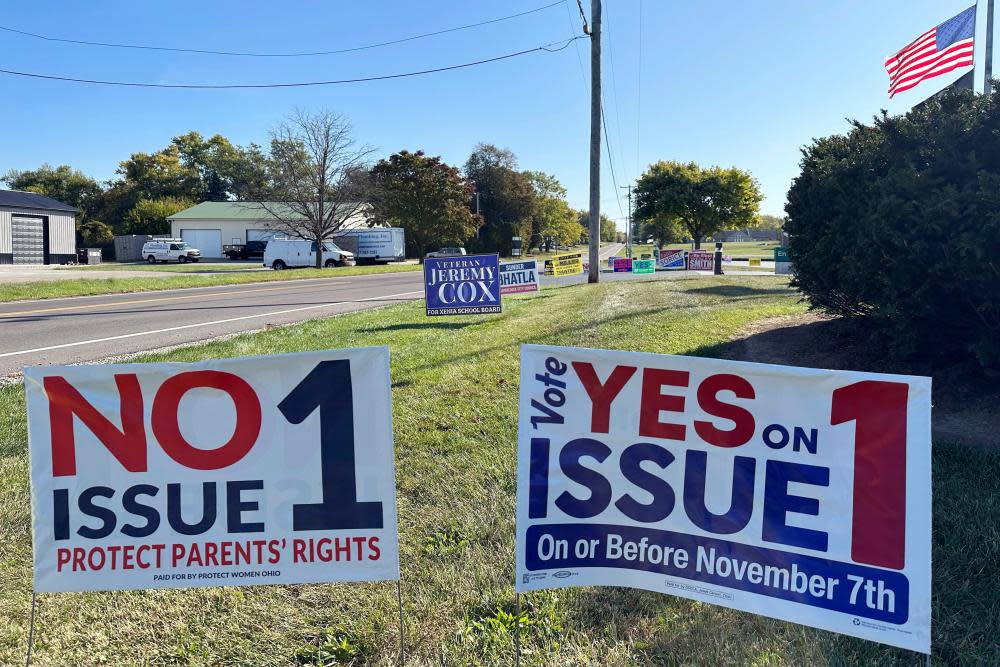Anti-abortion misinformation mounting ahead of key Ohio vote, experts warn

- Oops!Something went wrong.Please try again later.
Mike DeWine’s ad left Shyla Thurston infuriated.
Related: Abortion on the ballot: six US states with elections in 2023
In the ad, DeWine, Ohio’s Republican governor, stands next to his wife, Fran DeWine, as they speak directly to the camera. They assure voters that they have “carefully studied” Issue 1, the name of a November ballot initiative to enshrine abortion rights in Ohio’s state constitution. And, the couple say, they have realized it goes too far.
“Issue 1 would allow an abortion at any time during a pregnancy, and it would deny parents the right to be involved when their daughter is making the most important decision of her life,” Fran DeWine tells voters.
But Issue 1 would only allow abortions past fetal viability – a benchmark that generally occurs around 24 weeks of pregnancy – in certain cases. Legal experts say that the amendment is also unlikely to rewrite the existing Ohio law that already requires minors to get permission from their parents before they get abortions.
“They want to confuse you, so that you don’t vote for it. Instead of putting factual information out, it’s lies being put out there by elected officials that people trusted to vote in, and they’re there leading by lying,” said Thurston, a 37-year-old office manager who lives outside Columbus.
They want to confuse you, so that you don’t vote for it ... It’s lies being put out there by elected officials
Columbus resident Shyla Thurston
On Tuesday, Ohioans will vote on whether to amend the state constitution to enshrine the right to abortion. But powerful anti-abortion forces are arguing that the amendment will go beyond guaranteeing access to the procedure to imperil parents’ rights when it comes to abortion and even gender-affirming care. Experts and abortion rights supporters say these claims are spreading misinformation about the proposed amendment.
“It’s not about medical treatment. It’s not about gender identity. It is about reproductive freedom. It’s about abortion and other reproductive rights. It’s about adults,” said Tracy Thomas, director of the Center for Constitutional Law at the University of Akron School of Law. “These are just arguments trying to say this amendment is about something that it’s not.”
The DeWine ad is the work of a coalition known as Protect Women Ohio. Over the course of the campaign, Protect Women Ohio and affiliated groups have received millions from the influential anti-abortion group Susan B Anthony Pro-Life America, which operates out of Washington DC, as well as from the Concord Fund, an advocacy group linked to Leonard Leo, a behind-the-scenes power broker credited with helping to shape the US supreme court’s current conservative majority. (Abortion rights supporters are swimming in out-of-state money, too, with millions pouring in from billionaires and groups that are associated with them.)
Another ad paid for by Protect Women Ohio argues that if the amendment passes, children will be able to get gender-affirming care without their parents’ permission.

“Your daughter is young, vulnerable, online. Pushed to change her sex, or to get an abortion. You have some right to help her through this, but activists want to take all of that away,” one ad’s narrator declares, before the sound of a door slamming shut. “Under their proposed amendment to the Ohio constitution, the state shall not interfere with individuals getting abortions or sex changes.”
However, Issue 1 says nothing about gender-affirming care. If it passes, it would protect reproductive decisions “including but not limited to” the right to access contraception and fertility treatments, continue or end a pregnancy, and more.
While some forms of gender-affirming care can affect people’s ability to reproduce, some experts say the link is a stretch.
“There are a lot of things that we do that might have some bearing on our ability to reproduce. That doesn’t mean that all of those things are going to be protected,” said Jonathan Entin, an emeritus professor at Case Western Reserve University School of Law. “I get why people are focusing on the gender-affirming care issue. It’s a big, contentious issue. And it raises all sorts of questions that people have really strong views about. But just because it’s a contentious issue doesn’t necessarily mean that Issue 1 can sensibly be interpreted as protecting a way to gender-affirming care.”
If something is supported by the majority of people, it’s not actually a radical position
Akron resident Matthew Balsinger
If the amendment fails, Ohio may find itself under a six-week abortion ban, which briefly took effect after Roe v Wade was overturned but has since been paused by a state court. If the state’s supreme court decides to reinstate the ban, the consequences could reverberate across the midwest, since already-overwhelmed abortion clinics in the rest of the country will have to handle the onslaught of patients fleeing Ohio.
“They don’t seem to be focused on making an argument on the rhetoric – like ‘Hey, abortion destroys lives’ or ‘We support pro-life,’” said Matthew Balsinger, a 34-year-old high school science teacher who lives in the Akron area. “They don’t seem to be focusing on that message. They instead want to portray it as this cultural war: ‘Look how radical the people who are putting this forward are.’
“If something is supported by the majority of people, it’s not actually a radical position,” Balsinger added.

